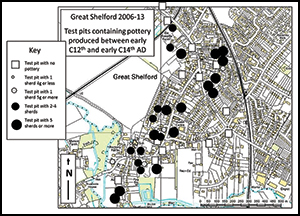Crossref Citations
This article has been cited by the following publications. This list is generated based on data provided by
Crossref.
Lewis, Carenza
2015.
Archaeological Excavation and Deep Mapping in Historic Rural Communities.
Humanities,
Vol. 4,
Issue. 3,
p.
393.
Jedwab, Remi
Johnson, Noel D.
and
Koyama, Mark
2016.
Bones, Bacteria and Break Points: The Heterogeneous Spatial Effects of the Black Death and Long-Run Growth.
SSRN Electronic Journal ,
More, Alexander F.
Spaulding, Nicole E.
Bohleber, Pascal
Handley, Michael J.
Hoffmann, Helene
Korotkikh, Elena V.
Kurbatov, Andrei V.
Loveluck, Christopher P.
Sneed, Sharon B.
McCormick, Michael
and
Mayewski, Paul A.
2017.
Next‐generation ice core technology reveals true minimum natural levels of lead (Pb) in the atmosphere: Insights from the Black Death.
GeoHealth,
Vol. 1,
Issue. 4,
p.
211.
Hale, Matthew
Raymond, Graham
and
Wright, Catherine
2017.
List of publications on the economic and social history of Great Britain and Ireland published in 2016.
The Economic History Review,
Vol. 70,
Issue. 4,
p.
1375.
Jervis, Ben
2018.
Assemblage urbanism. Becoming urban in late medieval Southampton.
Archaeological Dialogues,
Vol. 25,
Issue. 2,
p.
135.
Gallagher, Daphne E.
and
Dueppen, Stephen A.
2018.
Recognizing plague epidemics in the archaeological record of West Africa.
Afriques,
Vol. 09,
Issue. ,
Chouin, Gérard
2018.
Reflections on plague in African history (14th–19th c.).
Afriques,
Vol. 09,
Issue. ,
Roosen, Joris
and
Curtis, Daniel R.
2019.
The ‘light touch’ of the Black Death in the Southern Netherlands: an urban trick?.
The Economic History Review,
Vol. 72,
Issue. 1,
p.
32.
Kacki, Sacha
2020.
Encyclopedia of Global Archaeology.
p.
1465.
Vařeka, Pavel
2020.
Archaeology of the St. Nicholas Church in demolished village of Libkovice (Liquitz) – excavations in 1995–1996 (North Bohemian Brown Coal Mining Area) : a contribution to the research of medieval village churches in Bohemia.
Archaeologia historica,
p.
185.
Kacki, Sacha
2020.
Encyclopedia of Global Archaeology.
p.
1.
McCormick, Michael
2021.
Gregory of Tours on Sixth-Century Plague and Other Epidemics.
Speculum,
Vol. 96,
Issue. 1,
p.
38.
Bowden, Will
2021.
What is the role of the academic in community archaeology? The changing nature of volunteer participation at Caistor Roman town.
Journal of Community Archaeology & Heritage,
Vol. 8,
Issue. 2,
p.
79.
Gamble, Lynn H.
Claassen, Cheryl
Eerkens, Jelmer W.
Kennett, Douglas J.
Lambert, Patricia M.
Liebmann, Matthew J.
Lyons, Natasha
Mills, Barbara J.
Rodning, Christopher B.
Schneider, Tsim D.
Silliman, Stephen W.
Alt, Susan M.
Bamforth, Douglas
Hays-Gilpin, Kelley
Prentiss, Anna Marie
and
Rick, Torben C.
2021.
Finding Archaeological Relevance during a Pandemic and What Comes After.
American Antiquity,
Vol. 86,
Issue. 1,
p.
2.
Lewis, Carenza
van Londen, Heleen
Marciniak, Arkadiusz
Vařeka, Pavel
and
Verspay, Johan
2022.
Exploring the impact of participative place-based community archaeology in rural Europe: Community archaeology in rural environments meeting societal challenges.
Journal of Community Archaeology & Heritage,
Vol. 9,
Issue. 4,
p.
267.
Izdebski, A.
Guzowski, P.
Poniat, R.
Masci, L.
Palli, J.
Vignola, C.
Bauch, M.
Cocozza, C.
Fernandes, R.
Ljungqvist, F. C.
Newfield, T.
Seim, A.
Abel-Schaad, D.
Alba-Sánchez, F.
Björkman, L.
Brauer, A.
Brown, A.
Czerwiński, S.
Ejarque, A.
Fiłoc, M.
Florenzano, A.
Fredh, E. D.
Fyfe, R.
Jasiunas, N.
Kołaczek, P.
Kouli, K.
Kozáková, R.
Kupryjanowicz, M.
Lagerås, P.
Lamentowicz, M.
Lindbladh, M.
López-Sáez, J. A.
Luelmo-Lautenschlaeger, R.
Marcisz, K.
Mazier, F.
Mensing, S.
Mercuri, A. M.
Milecka, K.
Miras, Y.
Noryśkiewicz, A. M.
Novenko, E.
Obremska, M.
Panajiotidis, S.
Papadopoulou, M. L.
Pędziszewska, A.
Pérez-Díaz, S.
Piovesan, G.
Pluskowski, A.
Pokorny, P.
Poska, A.
Reitalu, T.
Rösch, M.
Sadori, L.
Sá Ferreira, C.
Sebag, D.
Słowiński, M.
Stančikaitė, M.
Stivrins, N.
Tunno, I.
Veski, S.
Wacnik, A.
and
Masi, A.
2022.
Palaeoecological data indicates land-use changes across Europe linked to spatial heterogeneity in mortality during the Black Death pandemic.
Nature Ecology & Evolution,
Vol. 6,
Issue. 3,
p.
297.
Stefański, Maciej
2022.
GDP effects of pandemics: a historical perspective.
Empirical Economics,
Vol. 63,
Issue. 6,
p.
2949.
Connah, Graham
2022.
Empires to be remembered.
p.
399.
Oksanen, Eljas
and
Lewis, Michael
2023.
Evaluating Transformations in Small Metal Finds Following the Black Death.
Medieval Archaeology,
Vol. 67,
Issue. 1,
p.
159.
Allfrey, Fran
Moore, Lucy
and
Nevell, Richard
2024.
Forging the medieval on Wikipedia.
postmedieval,
Vol. 15,
Issue. 2,
p.
549.
